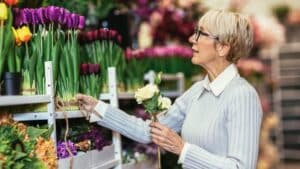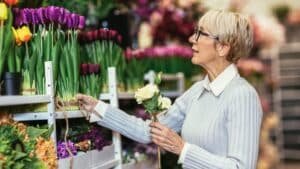
Let’s start with the care and feeding of flowers. By gaining this knowledge, you can save a life, one stem at a time, which goes some way toward making a beautiful lasting arrangement.
It is remarkable how delicate flowers can appear. But they are also remarkably hardy when you think about what they must go through to get to you.
Flowers Travel Long-Distance
Commercial flowers for the American market are primarily grown in Central America, Costa Rica, Chile, and El Salvador; the orient provides most tropical flowers. Holland is the best source of specialty flowers for weddings, out-of-season needs, and European access.
A tidbit: Much like the French wine grape crops had a fatal disease in the 19th century, destroying much of the wine grapes, the Dutch had a similar experience with their tulips. The tulips grown in the Skagit Valley of Washington State went a long way in helping the Dutch reignite their world-famous industry.
Commercial growers use multiple growing controls, from seedling production to soils and fertilizers, temperature, and light regulation, to improve the quality and durability of their products. Not all, but some have adopted earth-friendly methods. It is a consciousness that is growing.
Once harvested in the morning, the flowers are cleaned of all root stems and dirt, then are bunched and put in plastic sleeves, boxed with padding and ice packs, wood braces, and plastic strapping, then shipped out of the country, overnight, if without delay, to Customs in Florida or LA, etc.
Once cleared through Customs, the flowers are sent to wholesalers nationwide. They are re-packed with gel ice packs, wood braces, cushioning, and strapping, then shipped to retail establishments that sell to you. Wholesalers process flowers (details to follow) in plastic sleeves and store them in coolers until shops’ and designers’ orders are pulled.
The Life of a Flower Depends Mainly on Time
How much time has passed since the flowers was harvested until you brought them home?
It can often be as little as 12 -24 hours when all goes as scheduled; more often, it is a 36-hour journey. When things don’t go as planned, some floral orders can sit in a warehouse in the summer heat for three days, but that is a story for another time.
A suggestion: This journey is why it is well worth asking the floral department employee what days the flowers generally arrive at the store and how long the store keeps them if they don’t sell within a day or 2 or 3.
On to Processing
To me, processing evokes images of meat markets, which seems distasteful when used in parallel with the beauty flowers offer us and the feelings they produce. But it is an industry word and will help establish your floral designer street cred if used.
The steps become necessarily more complex the farther down the timeline from when the stems were harvested. They are now in your hands, awaiting the lifesaving methods you have learned to commence. I use the same steps for flowers and greenery.
Processing involves the steps we need to take to resuscitate and energize the flowers we bought.
Controlling the Environment
Flowers need energy and bacterial protection to live. Floral food and antibacterial elements are in those little packets that come with every purchase. Flowers need to be able to uptake those two elements, from stem to head, to be revived from the effects of their arduous journey.
Flowers need clean containers, clean water, and to be free of debris to better manage bacteria. If your packets were lost along the way, a small cap full of bleach and a couple of tablespoons of 7-up (I pick 7-up because it is clear) would achieve a similar end.
Free of debris also means the removal of any leaves and petals that would touch or go below the water line, including thorns on roses. They are on the stem to protect and feed them when they grow, but when cut and submerged in water, the container becomes a nursery where bacteria happily grow.
The amount of water varies to the stem length. Much of the leaves on the stem will be removed when designing, but if you are not sure and should choose to use less water, checking back once the processing is completed will be necessary to ensure enough water is in the container. Some of these guys are exceptionally thirsty, so make sure you pay attention to their needs.
Not Done Yet
Flowers will not be able to drink the magic elixir you made and in which you have placed them without prior preparation. Flower stems begin to harden at the base after they are harvested which is a protection mechanism.
Therefore it is essential to cut the stem tips off at least a half inch just before you put them in a clean bucket or container with clean water, food, and bacteria control. Hard, bark-like stems should be split at the bottom, do the banging thing. You have the cleaning thing firmly embedded.
If you put them in the water but pull them out again for some reason, it would be best to recut the stems; an air pocket may have formed and will block the uptake.
The processed flowers need to rest and drink. They should now be placed in the coolest environment, but not your refrigerator; they are good down on the floor unless your four-legged family member has a healthy curiosity streak. The floor is generally cooler than up on a table, but needs must, and they should always avoid direct light and heat.
Once you have processed your flowers in this way, you can leave them for about an hour before you start creating any special flower arrangement.
By the way, you do not put flowers in the fridge because of the off-gassing that comes with food, which is harmful to most flowers.
At this point flower processing is complete. Well done!
Next up, we will begin to create!
Let’s Have a Conversation:
How often do you buy flowers to arrange around your home? What flowers are your favorite? Do you know where they are grown? Do you take special steps to prepare them for life in your home?





